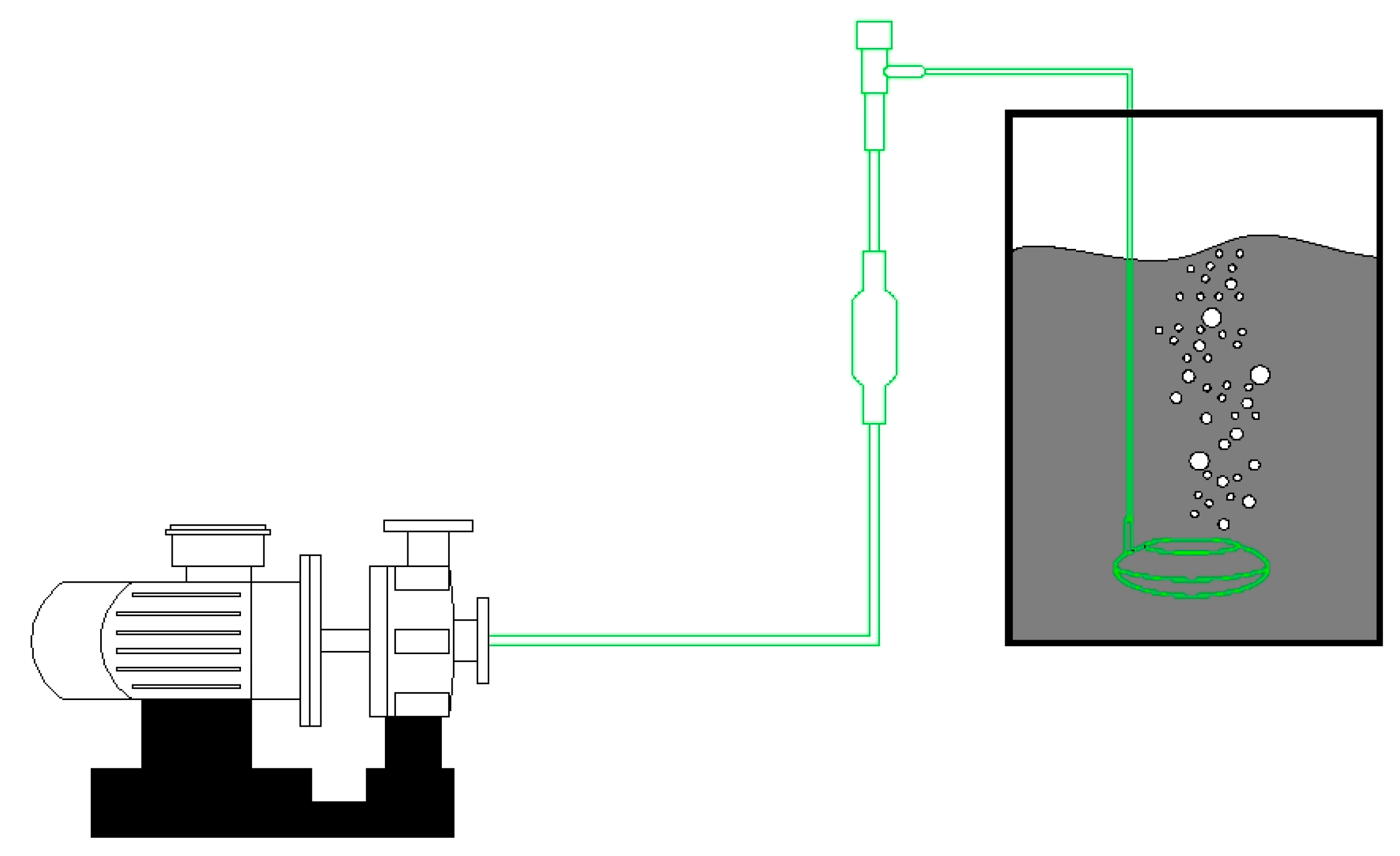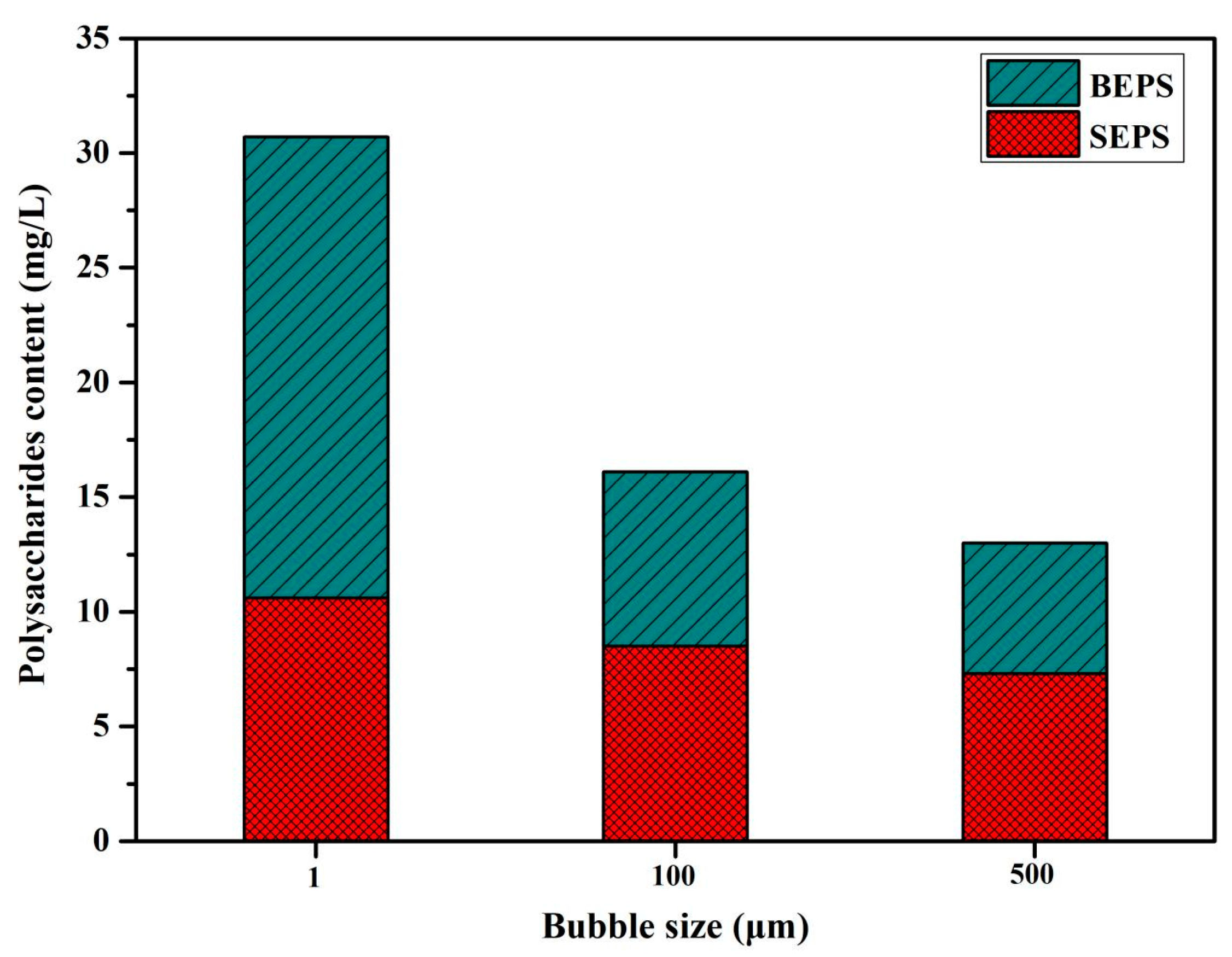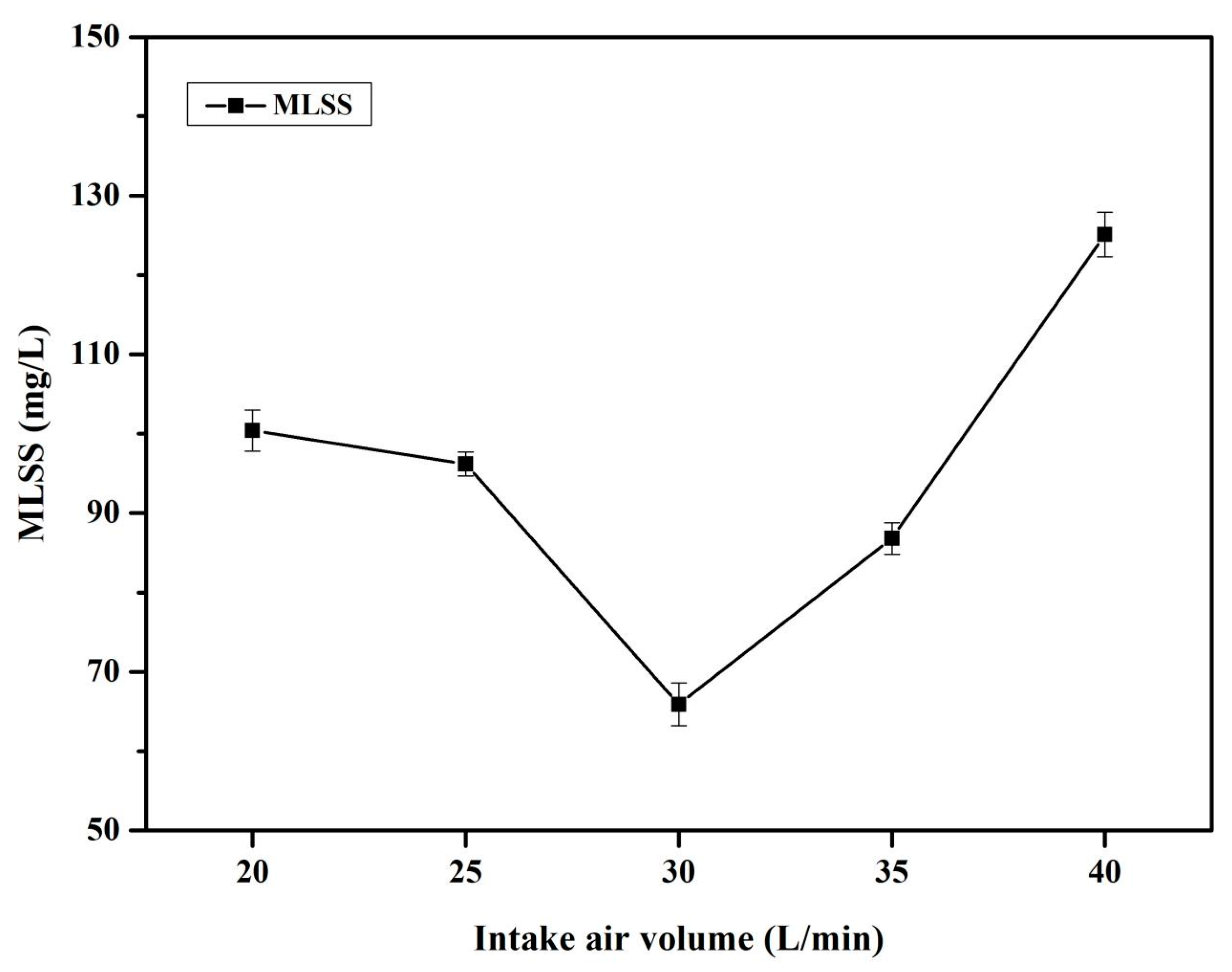Micro-Nano Bubbles Conditioning Treatment of Contaminated Sediment for Efficient Reduction: Dehydration Characteristic and Mechanism
Abstract
1. Introduction
2. Materials and Methods
2.1. Materials and Device
2.2. Experimental Procedures
2.3. Analysis Procedure
3. Results and Discussion
3.1. Orthogonal Experimental Analysis
3.2. Effect of Bubble Size on Contaminated Sediment Conditioning
3.3. Effect of Intake Air Volume on Contaminated Sediment Conditioning
3.4. Effect of Intake Air Volume on Contaminated Sediment Conditioning
3.5. SEM Analysis
4. Conclusions
Author Contributions
Funding
Data Availability Statement
Acknowledgments
Conflicts of Interest
References
- Wu, G.; Cao, W.; Wang, F.; Su, X.; Yan, Y.; Guan, Q. Riverine nutrient fluxes and environmental effects on China’s estuaries. Sci. Total Environ. 2019, 661, 130–137. [Google Scholar] [CrossRef] [PubMed]
- Wu, S.; Wu, Z.; Liang, Z.; Liu, Y.; Wang, Y. Denitrification and the controlling factors in Yunnan Plateau Lakes (China): Exploring the role of enhanced internal nitrogen cycling by algal blooms. J. Environ. Sci. 2019, 76, 349–358. [Google Scholar] [CrossRef]
- Meena, R.; Sathishkumar, P.; Ameen, F.; Yusoff, A.; Gu, F. Heavy metal pollution in immobile and mobile components of lentic ecosystems—A review. Environ. Sci. Pollut. Res. 2018, 25, 4134–4148. [Google Scholar] [CrossRef] [PubMed]
- Wu, Z.; Wang, C.; Jiang, H.; Li, K.; Yang, X.; Huang, W. Sediment pH structures the potential of the lake’s internal P pollution involved in different types of P reactivation. J. Clean. Prod. 2022, 352, 131576. [Google Scholar] [CrossRef]
- Zhang, Y.; Liu, G.; Gao, S.; Zhang, Z.; Huang, L. Effect of humic acid on phytoremediation of heavy metal contaminated sediment. J. Hazard. Mater. Adv. 2023, 9, 100235. [Google Scholar] [CrossRef]
- Chai, C.; Yu, Z.; Shen, Z.; Song, X.; Cao, X.; Yao, Y. Nutrient characteristics in the Yangtze River Estuary and the adjacent East China Sea before and after impoundment of the Three Gorges Dam. Sci. Total Environ. 2009, 407, 4687–4695. [Google Scholar] [CrossRef]
- Mai, B.; Fu, J.; Gan, Z.; Zheng, L.; Min, Y.; Sheng, G.; Wang, X. Polycyclic aromatic hydrocarbons in sediments from the Pearl river and estuary, China: Spatial and temporal distribution and sources. Appl. Geochem. 2001, 16, 1429–1445. [Google Scholar]
- Kibuye, F.; Zamyadi, A.; Wert, E. A critical review on operation and performance of source water control strategies for cyanobacterial blooms: Part II-mechanical and biological control methods. Harmful Algae 2021, 109, 102119. [Google Scholar] [CrossRef]
- Riza, M.; Ehsan, M.; Pervez, M.; Khyum, M.; Cai, Y.; Naddeo, V. Control of eutrophication in aquatic ecosystems by sustainable dredging: Effectiveness, environmental impacts, and implications. Case Stud. Chem. Environ. Eng. 2023, 7, 100297. [Google Scholar] [CrossRef]
- Liu, C.; Shao, S.; Shen, Q.; Fan, C.; Zhou, Q.; Yin, H.; Xu, F. Use of multi-objective dredging for remediation of contaminated sediments: A case study of a typical heavily polluted confluence area in China. Environ. Sci. Pollut. Res. 2015, 22, 17839–17849. [Google Scholar] [CrossRef]
- Wei, Q.; Liu, X.; Zhang, Y.; Zhang, K.; Li, Z.; Shen, Z.; Chow, C. Effect of tannic acid on the dewaterability of dredged sediment and the conditioning mechanism. J. Environ. Chem. Eng. 2021, 9, 104899. [Google Scholar] [CrossRef]
- Kumar, R.; Nagendran, R. Influence of initial pH on bioleaching of heavy metals from contaminated soil employing indigenous Acidithiobacillus thiooxidans. Chemosphere 2007, 66, 1775–1781. [Google Scholar] [CrossRef] [PubMed]
- Ringelberg, D.; Talley, J.; Perkins, E.; Tucker, S.; Luthy, R.; Bouwer, E.; Fredrickson, H. Succession of phenotypic, genotypic, and metabolic community characteristics during in vitro bioslurry treatment of polycyclic aromatic hydrocarbon-contaminated sediments. Appl. Environ. Microbiol. 2001, 67, 1542–1550. [Google Scholar] [CrossRef] [PubMed]
- Seiderer, L.; Newell, R. Analysis of the relationship between sediment composition and benthic community structure in coastal deposits: Implications for marine aggregate dredging. ICES J. Mar. Sci. 1999, 56, 757–765. [Google Scholar] [CrossRef]
- Rockers, P.; Tugwell, P.; Grimshaw, J.; Oliver, S.; Atun, R.; Røttingen, J.; Fretheim, A.; Ranson, M.; Daniels, K.; Luiza, V.; et al. Quasi-experimental study designs series–paper 12: Strengthening global capacity for evidence synthesis of quasi-experimental health systems research. J. Clin. Epidemiol. 2017, 89, 98–105. [Google Scholar] [CrossRef]
- Yang, N.; Xiao, H.; Pi, K.; Fang, J.; Liu, S.; Chen, Y.; Shi, Y.; Zhang, H.; Gerson, A.; Liu, D. Synchronization of dehydration and phosphorous immobilization for river sediment by calcified polyferric sulfate pretreatment. Chemosphere 2021, 269, 129403. [Google Scholar] [CrossRef]
- Berilgen, S.; Bulut, B. Laboratory investigations for dewatering of golden horn dredged sludge with geotextile tubes. Mar. Georesour. Geotechnol. 2016, 34, 638–647. [Google Scholar] [CrossRef]
- Chi, Y.; Guo, L.; Xu, Y.; Liu, J.; Xu, W.; Zhao, H. Rapid removal of bound water from dredged sediments using novel hybrid coagulants. Sep. Purif. Technol. 2018, 205, 169–175. [Google Scholar] [CrossRef]
- Han, S.; Li, J.; Zhou, Q.; Liu, G.; Wang, T. Harmless disposal and resource utilization of wastes from the lake in China: Dewatering, composting and safety evaluation of fertilizer. Algal Res. 2019, 43, 101623. [Google Scholar] [CrossRef]
- Wu, P.; Li, J.; Pi, K.; Li, Q.; Guo, X.; Yuan, J.; Wang, Z.; Wang, C.; Sun, P.; Shi, Y.; et al. Na2SO4 addition on electro-dewatering of urban river sediment by horizontal circular electric field: Comparison of three different electrodes. Dry Technol. 2019, 37, 1926–1938. [Google Scholar] [CrossRef]
- Song, Z.; Zhang, W.; Gao, H.; Wang, D. Comprehensive assessment of flocculation conditioning of dredged sediment using organic polymers: Dredged sediment dewaterability and release of pollutants. Sci. Total Environ. 2020, 739, 139884. [Google Scholar] [CrossRef] [PubMed]
- Cai, Y.; Wang, J.; Ma, J.; Wang, P.; Fu, H. A new method to improve the effectiveness of vacuum preloading on the consolidation of dredged fill in Wenzhou. Jpn. Geotech. Soc. Spec. Publ. 2016, 2, 1794–1797. [Google Scholar] [CrossRef]
- Guibal, E.; Vooren, M.; Dempsey, B.; Roussy, J. The use of chitosan for the removal of particulate and dissolved contaminants. ChemInform 2006, 37, 280. [Google Scholar] [CrossRef]
- Temesgen, T.; Bui, T.; Han, M.; Kim, T.; Park, H. Micro and nanobubble technologies as a new horizon for water-treatment techniques: A review. Adv. Colloid Interface Sci. 2017, 246, 40–51. [Google Scholar] [CrossRef] [PubMed]
- Lou, S.; Ouyang, Z.; Zhang, Y.; Li, X.; Yang, F. Nanobubbles on solid surface imaged by atomic force microscopy. J. Vac. Sci. Technol. B Microelectron. Nano Struct. 2000, 18, 2573–2575. [Google Scholar] [CrossRef]
- Masayoshi, T.; Taro, K.; Yoshitaka, Y.; Hirofumi, O.; Shouzou, H.; Hideaki, S. Effect of shrinking microbubble on gas hydrate formation. J. Phys. Chem. B 2003, 107, 2171–2173. [Google Scholar]
- Takahashi, M.; Chiba, K.; Li, P. Free-radical generation from collapsing microbubbles in the absence of a dynamic stimulus. J. Phys. Chem. B 2007, 111, 1343–1347. [Google Scholar] [CrossRef]
- Li, P.; Takahashi, M.; Chiba, K. Enhanced free-radical generation by shrinking microbubbles using a copper catalyst. Chemosphere 2009, 77, 1157–1160. [Google Scholar] [CrossRef]
- Tasaki, T.; Wada, T.; Fujimoto, K.; Kai, S.; Ohe, K.; Oshima, T.; Baba, Y.; Kukizaki, M. Degradation of methyl orange using short-wavelength UV irradiation with oxygen microbubbles. J. Hazard. Mater. 2009, 162, 1103–1110. [Google Scholar] [CrossRef]
- Wang, X.; Zhang, Y. Degradation of alachlor in aqueous solution by using hydrodynamic cavitation. J. Hazard. Mater. 2009, 161, 202–207. [Google Scholar] [CrossRef]
- Sun, Y.; Wang, S.; Niu, J. Microbial community evolution of black and stinking rivers during in situ remediation through micro-nano bubble and submerged resin floating bed technology. Bioresour. Technol. 2018, 258, 187–194. [Google Scholar] [CrossRef] [PubMed]
- Wang, L.; Li, Y.; Xiong, Y.; Mao, X.; Zhang, L.; Xu, J.; Tan, W.; Wang, J.; Li, T.; Xi, B.; et al. Spectroscopic characterization of dissolved organic matter from sludge solubilization treatment by micro-bubble technology. Ecol. Eng. 2017, 106, 94–100. [Google Scholar] [CrossRef]
- Wang, D.; Yang, X.; Tian, C.; Lei, Z.; Kobayashi, N.; Kobayashi, M.; Adachi, Y.; Shimizu, K.; Zhang, Z. Characteristics of ultra-fine bubble water and its trials on enhanced methane production from waste activated sludge. Bioresour. Technol. 2019, 273, 63–69. [Google Scholar] [CrossRef] [PubMed]
- Yang, X.; Nie, J.; Wang, D.; Zhao, Z.; Kobayashi, M.; Adachi, Y.; Shimizu, K.; Lei, Z.; Zhang, Z. Enhanced hydrolysis of waste activated sludge for methane production via anaerobic digestion under N2-nanobubble water addition. Sci. Total Environ. 2019, 693, 133524. [Google Scholar] [CrossRef]
- Yaparatne, S.; Doherty, Z.; Magdaleno, A.; Matula, E.; Garcia, S.; Apul, O. Effect of air nanobubbles on oxygen transfer, oxygen uptake, and diversity of aerobic microbial consortium in activated sludge reactors. Bioresour. Technol. 2022, 351, 127090. [Google Scholar] [CrossRef]
- Wang, X.; Lei, Z.; Zhang, Z.; Shimizu, K.; Lee, D.; Khanal, S. Use of nanobubble water bioaugmented anaerobically digested sludge for high-efficacy energy production from high-solids anaerobic digestion of corn straw. Sci. Total Environ. 2023, 863, 160825. [Google Scholar] [CrossRef]
- Zhou, S.; Liu, M.; Chen, B.; Sun, L.; Lu, H. Microbubble- and nanobubble-aeration for upgrading conventional activated sludge process: A review. Bioresour. Technol. 2022, 362, 127826. [Google Scholar] [CrossRef]
- Feng, Q.; Guo, K.; Gao, Y.; Liu, B.; Yue, Q.; Shi, W.; Feng, C.; Zhou, J.; Wang, G.; Gao, B. Effect of coagulation treatment on sludge dewatering performance: Application of polysilicate and their machanism. Sep. Purif. Technol. 2022, 301, 121954. [Google Scholar] [CrossRef]
- Ding, Y.; Tian, Y.; Li, Z.; Zuo, W.; Zhang, J. A comprehensive study into fouling properties of extracellular polymeric substance (EPS) extracted from bulk sludge and cake sludge in a mesophilic anaerobic membrane bioreactor. Bioresour. Technol. 2015, 192, 105–114. [Google Scholar] [CrossRef]
- Wang, T.; Chen, J.; Shen, H.; An, D. Effects of total solids content on waste activated sludge thermophilic anaerobic digestion and its sludge dewaterability. Bioresour. Technol. 2016, 217, 265–270. [Google Scholar] [CrossRef]
- Liu, J.; Zhang, Z.; Xue, W.; Siriweera, W.; Chen, G.; Wu, D. Anaerobic digestion of saline waste activated sludge and recovering raw sulfated polysaccharides. Bioresour. Technol. 2021, 335, 125255. [Google Scholar] [CrossRef] [PubMed]
- Xue, W.; Zeng, Q.; Lin, S.; Zan, F.; Hao, T.; Lin, Y.; Loosdrecht, M.; Chen, G. Recovery of high-value and scarce resources from biological wastewater treatment: Sulfated polysaccharides. Water Res. 2019, 163, 114889. [Google Scholar] [CrossRef] [PubMed]
- Wu, Y.; Zhang, P.; Zeng, G.; Jie, Y.; Liu, J. Enhancing sewage sludge dewaterability by a skeleton builder: Biochar produced from sludge cake conditioned with rice husk flour and Fecl3. ACS Sustain. Chem. Eng. 2016, 4, 5711–5717. [Google Scholar] [CrossRef]
- Lee, C.; Robinson, J.; Chong, M. A review on application of flocculants in wastewater treatment. Process. Saf. Environ. 2014, 92, 489–508. [Google Scholar] [CrossRef]
- Li, H.; Hu, L.; Xia, Z. Impact of groundwater salinity on bioremediation enhanced by micro-nano bubbles. Materials 2013, 6, 3676–3687. [Google Scholar] [CrossRef] [PubMed]
- Chen, G.; Lin, W.; Lee, D. Capillary suction time (CST) as a measure of sludge dewaterability. Water Sci. Technol. 1996, 34, 443–448. [Google Scholar] [CrossRef]
- Wang, W.; Fan, W.; Huo, M.; Zhao, H.; Lu, Y. Hydroxyl radical generation and contaminant removal from water by the collapse of microbubbles under different hydrochemical conditions. Water Air Soil Pollut. 2018, 229, 86. [Google Scholar] [CrossRef]
- Lin, H.; Wu, J.; Zhang, H. Degradation of bisphenol A in aqueous solution by a novel electro/Fe3+/peroxydisulfate process. Sep. Purif. Technol. 2013, 117, 18–23. [Google Scholar] [CrossRef]












| Number | Experimental Factors | ||
|---|---|---|---|
| Treatment Time (min) | Intake Air Volume (L/min) | Bubble Size (μm) | |
| 1 | 1 | 10 | 500 |
| 2 | 2 | 20 | 100 |
| 3 | 5 | 30 | 1 |
| Number | Treatment Time | Intake Air Volume | Bubble Size | CST/s |
|---|---|---|---|---|
| 1 | 1 | 1 | 1 | 325.6 |
| 2 | 1 | 2 | 2 | 382.3 |
| 3 | 1 | 3 | 3 | 136.9 |
| 4 | 2 | 1 | 2 | 224.7 |
| 5 | 2 | 2 | 3 | 263.5 |
| 6 | 2 | 3 | 1 | 343.2 |
| 7 | 3 | 1 | 3 | 244.7 |
| 8 | 3 | 2 | 1 | 281.6 |
| 9 | 3 | 3 | 2 | 163.8 |
| R | 51.6 | 94.5 | 101.8 |
Disclaimer/Publisher’s Note: The statements, opinions and data contained in all publications are solely those of the individual author(s) and contributor(s) and not of MDPI and/or the editor(s). MDPI and/or the editor(s) disclaim responsibility for any injury to people or property resulting from any ideas, methods, instructions or products referred to in the content. |
© 2023 by the authors. Licensee MDPI, Basel, Switzerland. This article is an open access article distributed under the terms and conditions of the Creative Commons Attribution (CC BY) license (https://creativecommons.org/licenses/by/4.0/).
Share and Cite
Zhang, Q.; Zhao, X.; Yin, J.; Sun, Z. Micro-Nano Bubbles Conditioning Treatment of Contaminated Sediment for Efficient Reduction: Dehydration Characteristic and Mechanism. Water 2023, 15, 1985. https://doi.org/10.3390/w15111985
Zhang Q, Zhao X, Yin J, Sun Z. Micro-Nano Bubbles Conditioning Treatment of Contaminated Sediment for Efficient Reduction: Dehydration Characteristic and Mechanism. Water. 2023; 15(11):1985. https://doi.org/10.3390/w15111985
Chicago/Turabian StyleZhang, Qingbo, Xuyuan Zhao, Jifu Yin, and Zhilin Sun. 2023. "Micro-Nano Bubbles Conditioning Treatment of Contaminated Sediment for Efficient Reduction: Dehydration Characteristic and Mechanism" Water 15, no. 11: 1985. https://doi.org/10.3390/w15111985
APA StyleZhang, Q., Zhao, X., Yin, J., & Sun, Z. (2023). Micro-Nano Bubbles Conditioning Treatment of Contaminated Sediment for Efficient Reduction: Dehydration Characteristic and Mechanism. Water, 15(11), 1985. https://doi.org/10.3390/w15111985





